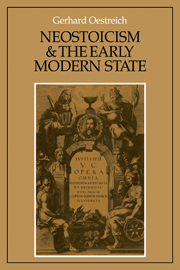Book contents
- Frontmatter
- Contents
- Foreword
- Introduction
- PART I JUSTUS LIPSIUS AND THE NETHERLANDS MOVEMENT
- 1 Constantia in publicis malis
- 2 The political intent in Neostoic philosophy
- 3 The main political work of Lipsius
- 4 Political Neostoicism
- 5 The military renascence
- 6 The European echo
- 7 The Netherlands movement in Brandenburg-Prussia
- PART II THE CONSTITUTIONAL DEVELOPMENT OF THE EARLY MODERN STATE
- Index
2 - The political intent in Neostoic philosophy
Published online by Cambridge University Press: 04 May 2010
- Frontmatter
- Contents
- Foreword
- Introduction
- PART I JUSTUS LIPSIUS AND THE NETHERLANDS MOVEMENT
- 1 Constantia in publicis malis
- 2 The political intent in Neostoic philosophy
- 3 The main political work of Lipsius
- 4 Political Neostoicism
- 5 The military renascence
- 6 The European echo
- 7 The Netherlands movement in Brandenburg-Prussia
- PART II THE CONSTITUTIONAL DEVELOPMENT OF THE EARLY MODERN STATE
- Index
Summary
Stoicism had played a part in European humanism before Lipsius, but the new Stoicism was only properly established by his Constantia and by his later, more systematic accounts of the ancient Stoa, in which he attempted to reconcile Stoicism and Christianity. Lipsius had many imitators. The best-known was Guillaume du Vair, whose treatise De la Constance et consolation ès catamités publiques was written during the tribulations of the siege of Paris and published immediately in 1593. Here too the mention of catamités publiques indicates the author's pre-occupation with politics, although du Vair, a Catholic who later became a bishop, combined Stoicism with Christianity to form a philosophical basis for the conduct of the political man.
The first task was to educate a new kind of man, the individual with a civic sense who would go beyond the Christianity of the Middle Ages, embrace the old Roman values, and demonstrate the importance of rationality in character, action and thought. Lipsius wanted men to be, in the Stoic sense, citizens of the world, not just of their own countries. In other words, the disciple of Seneca recognized country and state as realities and believed that we must stand up for them, but he did not put love of country on a par with the virtus of pietas, the natural love we owe to God and our parents. Nationalism is set against cosmopolitanism, or rather subordinated to it.
- Type
- Chapter
- Information
- Neostoicism and the Early Modern State , pp. 28 - 38Publisher: Cambridge University PressPrint publication year: 1982



